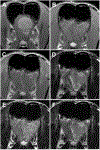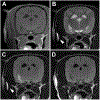Abrogation of fluid suppression in intracranial postcontrast fluid-attenuated inversion recovery magnetic resonance imaging: A clinical and phantom study
- PMID: 29424062
- PMCID: PMC7480189
- DOI: 10.1111/vru.12605
Abrogation of fluid suppression in intracranial postcontrast fluid-attenuated inversion recovery magnetic resonance imaging: A clinical and phantom study
Abstract
Postcontrast, fluid-attenuated inversion recovery (FLAIR) sequences are reported to be of variable value in veterinary and human neuroimaging. The source of hyperintensity in postcontrast-T2 FLAIR images is inconsistently reported and has implications for the significance of imaging findings. We hypothesized that the main source of increased signal intensity in postcontrast-T2 FLAIR images would be due to gadolinium leakage into adjacent fluid, and that the resulting gadolinium-induced T1 shortening causes reappearance of fluid hyperintensity, previously nulled on precontrast FLAIR images. A retrospective, descriptive study was carried out comparing T2 weighted, pre- and postcontrast T1 weighted and pre- and postcontrast weighted T2 FLAIR images in a variety of intracranial diseases in dogs and cats. A prospective, experimental, phantom, in vitro study was also done to compare the relative effects of gadolinium concentration on T2 weighted, T1 weighted, and FLAIR images. A majority of hyperintensities on postcontrast-T2 FLAIR images that were not present on precontrast FLAIR images were also present on precontrast T2 weighted images, and were consistent with normal or pathological fluid filled structures. Phantom imaging demonstrated increased sensitivity of FLAIR sequences to low concentrations of gadolinium compared to T1 weighted sequences. Apparent contrast enhancement on postcontrast-T2 FLAIR images often reflects leakage of gadolinium across normal or pathology specific barriers into fluid-filled structures, and hyperintensity may therefore represent normal fluid structures as well as pathological tissues. Findings indicated that postcontrast-T2 FLAIR images may provide insight into integrity of biological structures such as the ependymal and subarachnoid barriers that may be relevant to progression of disease.
Keywords: MRI; brain; cat; dog; gadolinium.
© 2018 American College of Veterinary Radiology.
Figures








Similar articles
-
Brain: gadolinium-enhanced fast fluid-attenuated inversion-recovery MR imaging.Radiology. 1999 Apr;211(1):257-63. doi: 10.1148/radiology.211.1.r99mr25257. Radiology. 1999. PMID: 10189481
-
Relationship between contrast enhancement on fluid-attenuated inversion recovery MR sequences and signal intensity on T2-weighted MR images: visual evaluation of brain tumors.J Magn Reson Imaging. 2005 Jun;21(6):694-700. doi: 10.1002/jmri.20331. J Magn Reson Imaging. 2005. PMID: 15906343
-
Exclusion of a brain lesion: is intravenous contrast administration required after normal precontrast magnetic resonance imaging?J Vet Intern Med. 2014 Mar-Apr;28(2):522-8. doi: 10.1111/jvim.12300. Epub 2014 Jan 27. J Vet Intern Med. 2014. PMID: 24467361 Free PMC article.
-
Clinical usefulness of labyrinthine three-dimensional fluid-attenuated inversion recovery magnetic resonance images in idiopathic sudden sensorineural hearing loss.Curr Opin Otolaryngol Head Neck Surg. 2021 Oct 1;29(5):349-356. doi: 10.1097/MOO.0000000000000744. Curr Opin Otolaryngol Head Neck Surg. 2021. PMID: 34459797 Review.
-
Contrast-Enhanced Fluid-Attenuated Inversion Recovery in Neuroimaging: A Narrative Review on Clinical Applications and Technical Advances.J Magn Reson Imaging. 2022 Aug;56(2):341-353. doi: 10.1002/jmri.28117. Epub 2022 Feb 15. J Magn Reson Imaging. 2022. PMID: 35170148 Review.
Cited by
-
Relationship between magnetic resonance imaging findings and histological grade in spinal peripheral nerve sheath tumors in dogs.J Vet Intern Med. 2023 Nov-Dec;37(6):2278-2290. doi: 10.1111/jvim.16839. Epub 2023 Sep 19. J Vet Intern Med. 2023. PMID: 37726924 Free PMC article.
References
-
- Falzone C, Rossi F, Calistri M, Tranquillo M, Baroni M. Contrast-enhanced fluid-attenuated inversion recovery vs. contrast-enhanced spin echo T1-weighted brain imaging. Vet Radiol Ultrasound. 2008;49: 333–338. - PubMed
-
- Bozzao A, Floris R, Fasoli F, Fantozzi LM, Colonnese C, Simonetti G. Cerebrospinal fluid changes after intravenous injection of gadolinium chelate: assessment by FLAIR MR imaging. Eur Radiol. 2003;13: 592–597. - PubMed
-
- Mathews VP, Caldemeyer KS, Lowe MJ, Greenspan SL, Weber DM, Ulmer JL. Brain: gadolinium-enhanced fast fluid-attenuated inversion-recovery MR imaging. Radiology. 1999;211: 257–263. - PubMed
MeSH terms
Substances
Grants and funding
LinkOut - more resources
Full Text Sources
Other Literature Sources
Medical
Miscellaneous

